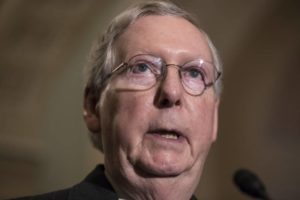
In this Dec. 5, 2017, photo, Senate Majority Leader Mitch McConnell, R-Ky., speaks on Capitol Hill in Washington. The pace of confirmations for President Donald Trump’s judicial nominees has quickly become a source of pride for Senate Majority Leader Mitch McConnell and fellow Republicans while Democrats are ruing the day they changed the rules to make it easier to fast-track court picks. (AP Photo/J. Scott Applewhite)
WASHINGTON (AP) — The pace of confirmations for President Donald Trump’s judicial nominees has quickly become a source of pride for Senate Majority Leader Mitch McConnell and fellow Republicans while Democrats are ruing the day they changed the rules to make it easier to fast-track court picks.
Nine confirmations in little more than a month have lifted the total number of judges confirmed during the Trump presidency to 16. Along with the major prize — Supreme Court Justice Neil Gorsuch — Trump can say he got more appellate court justices confirmed at this date in his presidency than any predecessor since Republican Richard Nixon.
Thanks to McConnell, Trump has one Supreme Court justice, nine circuit court appeals judges and six district court judges. These conservative men and women will serve for decades on the courts, shifting the balance rightward long after Trump’s time as president ends, and with it the tenure of several GOP senators.
“The #Senate has confirmed 3X the amount of Circuit Judges for @POTUS in his first year than President Obama,” McConnell crowed in a tweet crediting Judiciary Committee Chairman Chuck Grassley, R-Iowa.
But colleagues are doling out the praise for McConnell, too, knowing he has been a whipping boy for many anti-establishment Trump adherents.
“He gets credit on two counts. One is keeping a number of these judgeships open during the final year of the Obama administration,” said Sen. John Barrasso, R-Wyo. “Additionally, he made sure we get them all through the system … and get them voted on.”
Most notably, McConnell refused to consider Barack Obama’s choice of Merrick Garland for the Supreme Court, leaving the seat vacant for more than a year until voters chose a new president to make his selection.
“We’ve cemented a conservative majority on the Supreme Court for a generation,” McConnell said in an interview with The Associated Press late last week.
It’s a far cry from a few months ago when the Judicial Crisis Network, a conservative advocacy group, was preparing an ad campaign pushing McConnell and the Senate to speed the pace of confirmations.
Carrie Severino, chief counsel and policy director for the Judicial Crisis Network, said breaking “the most recent logjam of the judges was Leader McConnell saying this has got to stop.”
The pace of confirmations has left Democrats frustrated and dismayed.
There is little they can do to stop a nominee they deem unsuited for a lifetime appointment to the federal bench except stall. Thanks to steps then-Senate Majority Leader Harry Reid, a Nevada Democrat, put into motion three years ago, it no longer takes 60 votes to get a confirmation past a filibuster, the standard for the previous four decades.
Democrats changed the rules out of frustration with the GOP using the 60-vote threshold for confirmation to block Obama’s nominees to the U.S. Court of Appeals for the District of Columbia Circuit. But the short-term gain is turning into long-term pain for Democrats.
“The judiciary is so critical to the Republican right wing that we had to expect they were ready to move heaven and earth,” said Sen. Dick Durbin, D-Ill. “It was a big mistake if you think that we could have anticipated Donald Trump as president, and no one did. …. It turned out that we were wrong.”
“If we had foreseen the unprecedented misuse of authority in appointing judges, we probably would have thought better of changing the rules,” said another Democrat on the Judiciary Committee, Sen. Richard Blumenthal, D-Conn.
Democrats charge that the Republicans are rushing through nominees who are unqualified. They complain that Grassley is scheduling hearings for multiple circuit court nominees on the same day and that, under strong urging from McConnell, Grassley has upended the consultation process that presidents traditionally have with senators when making a nomination.
Under that process, senators submit a blue slip signaling their support for moving ahead with a nominee. Grassley has said that he will no longer allow vetoes for circuit court judges by a single senator who declines to return a positive blue slip. He said that is the policy that most Senate Judiciary Committee chairmen have followed over the past century, but Democrats note that that the last time a judge was confirmed without blue slips from both home state senators was 1989.
The blue slip process encourages the executive branch to consult with senators to find nominees that are satisfactory to both sides. Democrats say that weakening the standard will encourage a judiciary that is as partisan as the other two branches of government.
Trump courted social conservatives during the presidential campaign by listing federal and state court judges he would consider as a potential replacement for the late Justice Antonin Scalia. He repeatedly cited control of the Supreme Court as a top reason why Republican skeptics should rally around his candidacy. He’s followed through in his first year in office, to the point that Severino calls the slate of judicial confirmations the top accomplishment of the Trump presidency so far.
“The pace has finally picked up, which we are very happy about. Unfortunately the number of vacancies has held relatively steady,” Severino said. “We simply cannot take the foot off the gas.”

